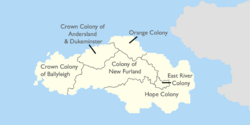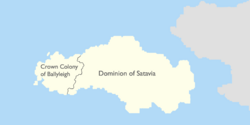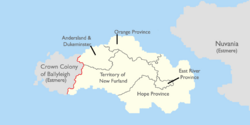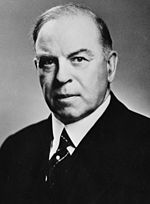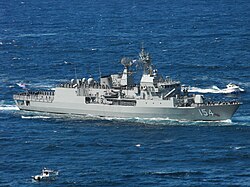Satavia
This article is incomplete because it is pending further input from participants, or it is a work-in-progress by one author. Please comment on this article's talk page to share your input, comments and questions. Note: To contribute to this article, you may need to seek help from the author(s) of this page. |
Satavian Federation | |
|---|---|
| Anthem: All Earthly Things Above | |
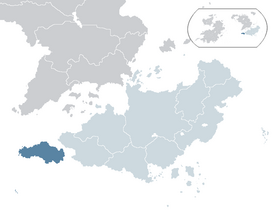 | |
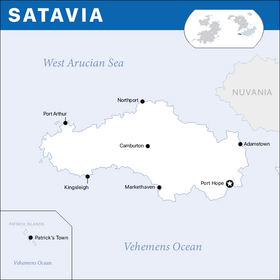 | |
| Capital and largest city | Port Hope |
| Official languages | Estmerish |
| Recognised national languages | Asteriaans Hennish |
| Recognised regional languages | Naua Roa |
| Ethnic groups (2015) | |
| Demonym(s) | Satavian |
| Government | Federal Parliamentary Republic |
| Jago Elliot | |
| Arthur Warwick | |
| Legislature | Parliament of Satavia |
| County Court | |
| House of Representatives | |
| Independence from Estmere | |
• Federation, Dominion | 1 October 1816 |
| 9 April 1928 - 15 March 1934 | |
• Proclamation of the Union | 21 September 1936 |
• Satavia Act, Independence | 23 September 1936 |
| Area | |
• Total | 663,130 km2 (256,040 sq mi) |
| Population | |
• 2018 estimate | 21,501,500 |
| GDP (nominal) | 2015 estimate |
• Total | $462.2 Billion |
• Per capita | $21,500 |
| Gini (2015) | medium |
| HDI (2015) | high |
| Currency | Satavian Guilder |
| Time zone | UTC+ 11 (Satavian Standard Time) |
| Date format | dd.mm.yyyy |
| Driving side | right |
| Calling code | +51 |
| Internet TLD | .sv |
Satavia, officially the Satavian Federation, is an Island Nation in Western Asteria Inferior, and shares a Maritime Border with Nuvania. The capital, largest city and biggest financial center is Port Hope. Satavia is made up of 5 semi-autonomous provinces, namely Balleyleigh, the Central Territory, the Hope Province, the Orange Province and the Northern Hope, each with an elected legislature and premier, and Naua Roa, an associated state of Satavia.
Satavia was first colonised briefly by various trade companies, most notably by the South Asterian Company, with the first trade post being set up in 1548. Various other settlements and trade posts were set up but then abandoned, with many companies favouring Nuvania due to it's rich natrual resource reserves. The first permanent settlements were established in 1649, all the way until 1719, and the creation of Flamian Asteria. Growth was stunted; and due to the relative prosperity of neighbouring Nuvania, many left Satavia. In 1747, following the Estmerish-Hennish War, in which Satavia and Nuvania were the sight of several major battles, the colony was ceeded to Estmere, who continued Flamian Asteria in the form of Estmerish Asteria. In 1778, the two colonies were once again split up, with Satavia becoming the Estmerish Hope. In 1811, Nuvania gained home rule, thus becoming a self-governing colony, whilst Satavia would also achieve home rule in 1816 following the Federation of Satavia. Post-federation, Satavia was elevated to Dominion Status, entering into a personal-union with Estmere as the Dominion of Satavia.
Estmerish rule would continue in Satavia until 1936. During this period, Satavia would see massive economic growth, along with the Satavian Population growing enormously and mass immigration. The period is often referred to in Satavia as the "Estmerish Miracle". Following the War of the Arucian and Nuvania's independence, Satavia remained a dominion of Estmere. Many of the colonists felt more in common with Estmere than the rest of the Asterias, and so politicians at the time didn't feel the need to seak independence from Estmere. During the Great Collapse, Satavia was impacted significantly hard, and continued to struggle well into 1922. The struggling dominion's Prime Minister, Sydney Warwick, appealed to Estmere for help, and, despite Estmere's own economic struggles, significant aid packages were sent to Satavia. Warwick would stear Satavia through the Collapse, and emerge stronger than ever.
During the Great War, Satavia's relatively small Armed Forces stood no chance against the greater powers of Nuvania and Satucin. Following Satavia's invasion, the Satavian Armed Forces made one last stand in Port Hope during the Defence of Port Hope. Satavia would remain occupied untill the Liberation of Satavia towards the end of the Great War, when Estmerish, Satavian and Hallandic forces landed to relatively little resistance.
Satavia's Prime Minister, Edward Limes, returned with members of the Exiled Government in February 1935. Limes arrived to find some of Satavia in ruins physically, and much in ruins economically, and in March unveiled the Five Year Rejuvination, designed as an economic stimulus package that would, in five years, rebuild Satavia. In 1936, Limes was informed by King William III that due to the unfolding situation in Estmere, he planned to abdicate. Upon the abolition of the monarchy in Estmere (which in turn also abolished the monarchy in Satavia and terminated the personal union between the two states), Edward Limes proclaimed the formation of the Union of Satavia, which would only last for three years before it's abolition. Limes won the 1936 General Election in a landslide victory, and served until 1939, when following the viewed "ineffectiveness" of the Union, and proposals to slash the Armed Forces Budget, lead to the Army, under the control of Field Marshal Oscar Harrison, to occupy the country and proclaim the Republic. Limes was exiled, along with a large portion of the previous government. Harrison would only hold the position for two years, before he was asssainated in March 1941.
Harrison was a National Party member, a far right political organisation, and so became the first National Prime Minister. The Nationals would control politics for the next 40 years, however, Harrison would only remain in control for two years, before he was assassinated.
Following the 1973 Constitutional Ammendments, which removed the right to a fair trial, one of the last remaining civil liberties held by Satavians, started three years of disturbances in the country, that culminated in the 1976 Satavian Riots that lead to the collapse of the last National Government, lead by Dick Bleum. Following the 1976 General Election, the left-wing SDP won a landslide result. Angered by what was percieved by right-wing groups as the fall of Satavia to the left, many of these Paramilitaries took up arms against the new government, starting the Satavian Crisis, in which an estimated 7,400 people died, with just over 4,100 of them being innocent civilians. Initially, Satavian forces failed to beat back the paramilitaries, and in January 1978, the government made an appeal for help to the Organization of Asterian Nations, and by march an OAN Peacekeeping force had arrived, largely comprised of Hallandic and Nuvanian Forces. The crisis made headlines internationally when a NLM Flight from Pietersburg to Port Hope was blown up over the town of Lingbury, resulting in the deaths of 59 people. The Nuvanian Government alleged De Volksmilitie involvement, but the group never confirmed nor denied wether they planted the bomb on the airliner. The crisis ended in 1983, with a decisive government victory.
Satavia is a developed nation, with the country seeing rapid growth from the end of the Satavian Crisis. Satavia is a member of the Community of Nations, International Council for Democracy, the Organization of Asterian Nations, the Estmerish Council and the Asteria Inferior Common Market, in addition to being an associate member of the North Vehemens Organization.
Etymology
History
Pre-Historical
Colonisation Period
Dominion of Satavia and Federation
In February 1811, Nuvania was granted home rule by Estmere. Previous requests by the colonies of the Satavian Isles for dominion status had been refused on the basis that officials in Morwall had ruled that for home rule status to be granted, federation must be achieved. Various proposals for federation had been brought up since the 1790s, but nothing of substance was ever agreed upon.
At the July Convention, representatives from the six colonies (Crown Colony of Andersland & Dukeminster, the Hope Colony, Crown Colony of Ballyleigh, the Orange Colony, Colony of New Furland and the East River Colony) met in Port Jago to discuss the proposition of federation in July 1812. Whilst several colonies supported federation followed by home rule, some (including the East River Colony and the Crown Colony of Ballyleigh) believed that economically it was disadvantageous to join a larger single entity. The following three years of negotiations, led primarily by the Hope Colony, saw the first of four bills submitted to each colony, the first entitled "On the Topic of Federation", introduced in 1814. The first proposal was accepted by the Hope Colony and the Orange Colony but was rejected by the remaining colonies. In 1815, the Hope Colony and the Orange Colony merged to form the Colony of Satavia, which marks the first time the name "Satavia" was used.
The other colonies initial refusal of federation is generally attributed to economic differences, as opposed to social and ethnic differences. Many of the colonies were worried that the Hope Colony, by far the most powerful, developed and influential would exploit the smaller colonies. In early 1816, the fourth and final bill was submitted to each of the remaining colonies not yet part of the Colony of Satavia - which included land transfers to Ballyleigh and the Orange Colony and the guarantee of a federal structure in which each province would retain the post of governor and each of the province's legislatures (which had been established in 1800 to manage local affairs).
The only province not to agree was Ballyleigh, which felt that it was not economically in Ballyleigh's interests to join the new Dominion. Consequently, Ballyleigh did not join the federation in 1816. When the Colony of Satavia was granted Dominion Status under the Home Rule (Satavia) Act, 1816, it did not include Ballyleigh under the new Dominion. The new Dominion held it's first election before even gaining Dominion Status - so that on the 1st of October when home rule was officially transferred to Satavia, Richard Somerset, who was previously Governor of the Orange Colony, made it a priority to incorporate Ballyleigh into the Dominion. Somerset began talks with the Governor of Ballyleigh, Cedric D. Johnson, offering large financial bonuses and a land exchange that would see the major settlements of Kingsleigh and Port Jago both transferred to Ballyleigh. In 1818, Ballyleigh submitted a request to the metropolis for home rule and Dominion status - which was refused.
In 1819, Somerset tried again, offering an even more generous offer - but once again, Jonhson refused and counter-offered - if the capital of Satavia was moved to Port Arthur, Johnson would agree. Moving the capital to Port Arthur would give Ballyleigh the most power out of any of the Provinces - but this was refused by Somerset. Various attempts would be made over the next seven years of Somerset's premiership, but when he was defeated in the 1827 General Election, his successor, Arthur Mann, did not attempt to integrate Ballyleigh into the Dominion.
In 1836, the Great Drought crippled Ballyleigh's largely agrarian economy. It also prompted the government of the colony, now run by Samuel O'Donovan, a descendent of one of the many Caldish migrants that emigrated to Ballyleigh in the 1700s, to ask for funds from Estmere, which was rejected. Next, he turned to the Dominion of Satavia, which largely had not been affected by the Drought due to the nature of the Dominion's economy, and large currency reserves. However, a certain level of animosity had existed between the Dominion and Ballyleigh since Ballyleigh refused federation. Following further talks and Ballyleigh's slide into an economic depression, O'Donavon agreed to admit Ballyleigh into the Dominion. Under the agreement, Ballyleigh received significant funding, and increased in size, gaining, as promised in 1815, Port Jago and Kingsleigh.
Ballyleigh's entry into the Dominion in 1838 meant that suddenly the Dominion found itself with the agrarian powerhouse that Ballyleigh was, and soon became known as the "Breadbasket of the Estmerish Empire". Within two years of joining the Dominion, Ballyleigh was lifted out of its economic slump, and in the 1839 election, representatives from Ballyleigh were sent to Port Hope for the first time.
In 1844, the Dominion entered a period called the "Estmerish Miracle". During this period, immigration to Satavia was at an all-time high, and business flourished. Soon, purchasable land in the East of the Country became scarce, and so, under the Grim-Morley administration, huge swathes of native land were repossessed from the natives. Previously, the Estmerish administration had retained previous agreements made between the colonies (and agreements made by the Hennish). Thousands of natives were cleared from their homes and often killed, by local militias tasked with expelling the natives from their land.
In 1845, less than a year after the expulsions began, the native Rookerama tribe began attacking convoys and rural settlements in the main interior, ravaging, in particular, the East River Province. This marked the first time of confrontation with the native tribes - and the beginning of the First Estmerish-Rookerama War. It would end only four months after it started, following the establishment of a native reserve that straddled the border of the East River Province and the Hope Province. However, the war hadn't solved the immediate need for land. So, in 1846, more land was seized from the Rookerama tribe, including the reservation, which led to the Second Estmerish-Rookerama War. The war saw a few pitched battles but was mainly a guerilla conflict. Despite the nature of the conflict and the Rookerama's expert knowledge of the area, they were eventually defeated in 1848 and were forced to flee westward, into New Furland, where they were allowed to roam the vast swathes of uninhabited lands, mainly in the Orange Mountains. The "Estmerish Miracle" never ended with a crash, it simply petered out, and by 1859, Satavia's economy was growing at a steady rate.
In 1855, the Dominion elected Johan van Vallier, a Conservative politician who would dominate Dominion politics up until 1879. Johan van Vallier was ardently pro-Pioneer and clashed with Morwall many times during his premiership, mainly due to the relatively liberal Estmerish foreign and colonial policy.
1883 saw the election of Arthur O'Connell - one of the three Political Giants of the Dominion - but it also saw the beginning of the War of the Arucian, which Satavia wasn't directly involved in, but it had a major political effect on the country. Nuvania was drawn into the war due to a secret treaty, whilst Satavia did not join the war as it was not involved in these treaties. When the war ended, however, it massively changed the political landscape - Nuvania, a fellow dominion, declared independence, whilst Satavia remained Estmerish. It also meant that Satavia itself was distanced from the continent and was largely cut off from Asterian affairs.
O'Connell's time as Prime Minister saw poverty skyrocket throughout the country - but also saw Satavia develop a distinct culture, and a sense of nationhood - and also increased calls for independence, with an Independence movement being established for the first time. Poverty reached an all-time high during the Great Collapse, where Sydney Warwick - the third of Satavia's Political Giants - was elected to help combat the Great Collapse, which he did. The collapse had ravaged the struggling dominion, which had previously relied on Estmere and Nuvania for everything other than agricultural products. Warwick's economic stimulus packages helped lift the Dominion out of poverty, whilst also helping with the pre-existing poverty problem.
In 1927, Estmere and Satavia joined the war that was quickly becoming global against Gaullica. Later that year, however, Nuvania joined the war on the side of Gaullica, and suddenly Satavia's position was no longer secure. Many of Estmere's troops and ships had been withdrawn, leaving only a small contingent of Estmerish soldiers in Port Hope, in addition to some poorly-trained Satavian forces.
Great War
On the 3rd April, a large force of 26,000 Nuvanian soldiers landed to the South of Port Hope, at Missionaire Baai. Despite the landings only being 3.5 miles from the outskirts of Port Hope, they were obscured by a thick mist and King Charles Mound, a strategic hill overlooking Port Hope. The landings were unopposed, and Satavian forces were overwhelmed very quickly. Regrouping, several pitched battles were made to retake King Charles Mound, but never succeded, and on the 9th General Harrison surrendered his forces in Port Hope.
Following the fall of Port Hope, any remaining Satavian forces were evacuated at Port Arthur, including the Royal Satavian Navy, and sent to Euclea. Sporaddic resistance continued for the next week, but soon Nuvanian forces were in control of the vast majority of the country. The defeat had been a propoganda disaster for Estmere, who now seemed as if they couldn't even protect their own colonies.
Satavian forces fought in Estmere and other Estmerish colonial possesions, but were distrusted by Estmerish commanders, and brushed off as "colonials". On the 3rd March 1934, a joint Grand Alliance force lead by Lft. Gen. James Warwick (Operation Blind Summit) landed near Northport, in the Orange Province. The landings were successful and within two weeks, any remaining Entente resistance was flushed out. A joint Hallandic-Satavian Military Command ran the country until the end of the war, when, on the 13th February, Prime Minister Edward Limes and Governor-General Sydney Warwick returned to Satavia.
Union of Satavia
1939 February Coup
Republic of Satavia
Satavian Crisis
Return to Democracy
21st Century
Geography
Government & Politics
Government
Legislature
|
House of Representatives Government Conservative: 151 seats Oppositon Labor: 66 seats Other Opposition Liberal: 17 seats Green: 4 seats New National: 11 seats
Conservative: 40 seats Country: 21 seats Opposition Labor: 33 seats Other Opposition Liberal: 5 seats New National: 1 seat |
Satavia's Parliament of Satavia is the bicameral legislature of Satavia. Comprised of two houses, the House of Representatives (commonly called the House) and the County Court (commonly called the Court).
The House of Representatives, Satavia's lower house, is made up of 249 directly elected representatives, all of whom have a constituency. Members of Parliament are elected at a General Election every four years or earlier, and there is no term limit for an MP. The House's main function is to draft bills, pass bills and send them to the County Court, and if they are passed there they become laws, and if they are rejected they are returned to the House to be ammended (including the annual budget).
The County Court, Satavia's upper house, is made up of 100 County Senators following the 2021 Court Election (98 in 2016), and the ammount of senators changes per province. For example, Balleyleigh sends 26 senators, whilst the Orange Province sends 6. The Court's main responsibility is reviewing legislation sent by the House, and either approving it, or returning it to the House to be ammended. The Court also consists of a large ammount of non-partisan Senators, many of whom have held their seats for many years. County Senators come up for election every five years, except in Balleyleigh, where they come up for election every seven years. Regardless of who has a majority in the County Court, the President will come from the party with a majority in the House, unless two or more political parties have come to an agreement that only affects the County Court.
The Prime Minister sits in the House of Representatives, whilst the President sits in the County Court. Both are usually from the same party, although due to the fact that elections for both houses are different (the House has General Elections every four years, whereas the Court also has elections every four years on a different schedule).
Administrative Divisions
Satavia is divided into three levels of subdivisions, tier 3, tier 2 and tier 1 level subdivisions. Tier 3 subdivisions are the highest level of subdivision, and there are 5 subdivisions that fall under this category; all five are provinces.
The five provinces are, in order of population size, the Hope Province, Ballyleigh, the Northern Hope, the Orange Province and the Central Territory. All provinces are located on the Satavian mainland.
Each province has it's own elected premier and legislative assembly, with each provincial government passing legislation, on the condition that it doesn't undermine federal law. Provinces also have control of the Emergency Services in that province, including law enforcement agencies.
The next tier subdivision - tier 2 - are the Counties and Metropolitan Areas (for censuses, these are designated as County and Metropolitan Census Area - CMCA) - of which there are 49, including three located on the Patrick Islands, an associated state of Satavia.
The lowest tier, tier 1, are Districts, and district-equivilant subdivisions such as Boroughs and Parishes. There are 289 tier 1 subdivisions.
| Name | Abbreviation | Population | % National | Capital | Capital CMCA |
|---|---|---|---|---|---|
| East Country • Provinces of the East Country • | |||||
| HP | 9,549,162 | 44.41% | Port Hope (de jure) Markethaven (de facto) | Port Hope Metropolitan Area | |
| NH | 3,999,748 | 18.60% | Adamstown | County Veld | |
| West Country • Provinces of the West Country • | |||||
| BA | 6,335,140 | 29.40% | Port Arthur | Port Arthur-Fort Kinnon | |
| CT | 188,345 | 0.87% | Camburton | County Talbot | |
| OP | 1,429,105 | 6.65% | Northport | County Northport | |
| Total | 21,501,500 | ||||
Largest Cities
Largest cities in Satavia
Satavian Census Committee | |||||||||
|---|---|---|---|---|---|---|---|---|---|
| Rank | Province | Pop. | Rank | Province | Pop. | ||||
 Port Hope Port Arthur-Fort Kinnon |
1 | Port Hope | Hope Province | 3,568,722 | 11 | Hoorn | Hope Province | tbd | Adamstown Adamstown  Kingsleigh |
| 2 | Port Arthur-Fort Kinnon | Ballyleigh | tbd | 12 | Vaalstad | Northern Hope | tbd | ||
| 3 | Adamstown | Northern Hope | tbd | 13 | Talbot | Central Territory | tbd | ||
| 4 | Kingsleigh | Ballyleigh | tbd | 14 | Camburton | Central Territory | tbd | ||
| 5 | Markethaven | Hope Province | tbd | 15 | Fort Dent | Hope Province | tbd | ||
| 6 | Burnaby | Hope Province | tbd | 16 | Port Jago | Ballyleigh | tbd | ||
| 7 | Northport | Orange Province | tbd | 17 | Windstad | Northern Hope | tbd | ||
| 8 | Kingstown | Northern Hope | tbd | 18 | Voralburg | Hope Province | tbd | ||
| 9 | Grangefontein | Orange Province | tbd | 19 | East River | Hope Province | tbd | ||
| 10 | Victoriaburg | Ballyleigh | tbd | 20 | Port Elliot | Ballyleigh | tbd | ||
Military
The Satavian Armed Forces comprise of the Satavian Army, the Satavian Naval Service (previously the Royal Satavian Navy) and the Satavian Air Force. In recent years, the combined Armed Forces budget has been slashed by nearly 40%, following decades of unnecessary expenditure, much of it by the Satavian Dictatorship that was in power until 1976.
All citizens (with the exception of university students and those employed in certain areas of the public sector) aged 18-22 are elligible to take part in a two year period of national service, many however opt not to serve their national service time in the Armed Forces.
During the Satavian Crisis, the previously poorly-trained Armed Forces were given a professional training by Hallandic Advisors, and Satavia retains close military ties with Halland, Satavia being an associate member of the NVO.
Satavia's Army consists of nearly TBD men and women, whilst Satavia's Navy maintains a fleet of 17 ships, including a single LPH, which was purchased from Halland in 1999, in addition to a Dock Landing Ship, aslo purchased from Halland. The Satavian Airforce consists of TBD planes.
Foreign Affairs & International Standing
Satavia retains very close relations with her neighbour Nuvania, due to historical ties (both were Hennish and later Estmerish Colonies), and Satavia remains the only country Nuvania has a free travel agreement, and both were present at the signing of the Kingsleigh Treaty, along with Satucin, that eventually lead to the creation of the Asteria Inferior Common Market. Satavia's relations with Nuvania have rarely been strained, other than the Great War, where Satavia, at that point still a Dominion of Estmere, briefly fought, and then surrendered to Nuvanian Forces.
Satavia also retains close relations with other countries in the Asterias, most notably Halland, who's cultural and political impact during their four year deployment during the Satavian Crisis later lead to closer ties with Halland, and Associate Member status in the NVO.
Futher abroad, Satavia maintains close relationships with Estmere, often called "The Mother Country" colloquially. Estmerish remains Satavia's most used language, and one of two official languages in the country. Satavia also maintains good relations with other countries in Euclea, such as Caldia and Gaullica.
The Patrick Islands, officially Naua Roa, are, according to the Satavian Government, an independent country in free association with Satavia - however, the CN and the majority of CN member states maintain that the islands are non-self governing and are involuntarily an associated state of Satavia.
Satavia is a member of the Community of Nations, ASTCOM, International Council for Democracy, the Organization of Asterian Nations and the Estmerish Council, in addition to being an associate member of the NVO.

